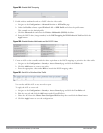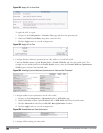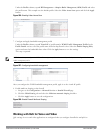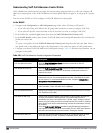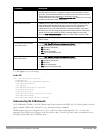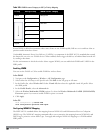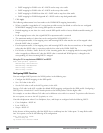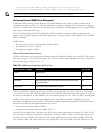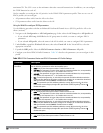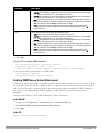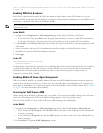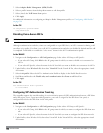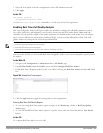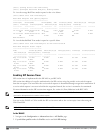
any destination [LYNC_SERVER] [LYNC_PORTS] permit tos 44 dot1p-priority 6
any destination [SCOPiA_SERVER] [SCOPIA _PORTS] permit tos 42 dot1p-priority 6
NOTE: You must know the ports on which each traffic is sent so that the correct traffic is identified.
Configuring Dynamic WMM Queue Management
Traditional wireless networks provide all clients with equal bandwidth access. However, delays or reductions in
throughput can adversely affect voice and video applications, resulting in disrupted VoIP conversations or dropped
frames in a streamed video. Thus, data streams that require strict latency and throughput need to be assigned higher
traffic priority than other traffic types.
The Wi-Fi Alliance defined the Wi-Fi Multimedia (WMM) standard in response to industry requirements for
Quality of Service (QoS) support for multimedia applications for wireless networks. This is defined as per the IEEE
802.11e standards.
WMM requires:
l The access point is Wi-Fi Certified and has WMM enabled
l The client device is Wi-Fi Certified
l The application supports WMM
Enhanced Distributed Channel Access
WMM provides media access prioritization through Enhanced Distributed Channel Access (EDCA). EDCA defines
four access categories (ACs) to prioritize traffic: voice, video, best effort, and background. These ACs correspond to
802.1p priority tags, as shown in Table 302.
WMM Access Category Description 802.1p Tag
Voice Highest priority 7, 6
Video Prioritize video traffic above other data traffic 5, 4
Best Effort Traffic from legacy devices or traffic from applications or devices that
do not support QoS
0, 3
Background Low priority traffic (file downloads, print jobs) 2, 1
Table 302:
WMM Access Categories and 802.1p Tags
While the WMM ACs designate specific types of traffic, you can determine the priority of the ACs. For example,
you can choose to give video traffic the highest priority. With WMM, applications assign data packets to an AC. In
the client, the data packets are then added to one of the transmit queues for voice, video, best effort, or background.
WMM is an extension to the Carrier Sense Multiple Access with Collision Avoidance (CSMA/CA) protocol’s
Distributed Coordination Function (DCF). The collision resolution algorithm responsible for traffic prioritization
depends on the following configurable parameters for each AC:
l arbitrary inter-frame space number (AIFSN)
l minimum and maximum contention window (CW) size
For each AC, the backoff time is the sum of the AIFSN and a random value between 0 and the CW value. The AC
with the lowest backoff time is granted the opportunity to transmit (TXOP). Frames with the highest-priority AC
are more likely to get TXOP as they tend to have the lowest backoff times (a result of having smaller AIFSN and
CW parameter values). The value of the CW varies through time as the CW doubles after each collision up to the
DellPowerConnectW-SeriesArubaOS6.2 | User Guide Voiceand Video | 700



